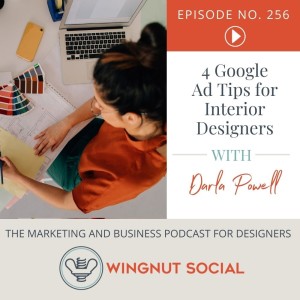
What is a Google ad? How can you leverage Google ads to drive leads to your interior design business? How do you stand out against your competition? In this solo episode of Wingnut Social, Darla dives into the need-to-know basics of Google ads. It’s a great strategy—in conjunction with SEO—to drive traffic to your website and help you build your business.
What You’ll Hear On This Episode of Wingnut Social- [2:02] March 24th at 11 am: Stacey Martin Webinar
- [3:07] Mini News Sesh: The Career Gap feature on LinkedIn
- [5:47] Your marketing strategy: Google ads and SEO
- [8:17] Tip #1: Control what your audience sees with ad extensions
- [15:16] Tip #2: Leverage keywords in Google ads
- [17:08] Tip #3: Create a high-quality ad
- [20:40] TIp #4: Be specific
- [25:01] Blooper Reel!
- March 24th at 11 am: Stacey Martin Webinar
- Episode #250 with Stacey Martin
When you search on Google, the first four or five results say “ad” in the top left corner. Usually, you’ll see results related to the topic you searched for. Advertisers pay to get their ads on the page for that search.
Google ads are a great way to cut in line and get on the first page of Google and it’s a whole lot faster than SEO. SEO is still heavily important. You want the right keywords placed in particular places on your website. Why? So when someone searches for “Interior Designer Philadelphia” your business is in the top 10 search results.
But proper SEO is a time-consuming process. It’s a long game, not a quick win. You have to invest a lot of time and often money to begin to see traction (sometimes it takes over a year). It’s a necessary evil—you have to do it—but Google ads are a great way to gain some traffic to your site now.
If your ad is structured properly, for the right amount of money, you can show up on the top of the first page. So when someone searches for “Susan McNuggets Interior Designer” they’ll find you. Even if your SEO is on par and you’re #1 in the search results, ads will still be placed above your business. That’s why ads are a great way to beat out the competition.
Tip #1: Control what your audience sees with ad extensionsAt the top of the search results, you’ll see your headline. Underneath that, you’ll see categories that are called site extensions (i.e. for “Wingnut Social” you’ll see “podcast,” “social media marketing agency,” etc.). Google is searching the organic copy of your website and making the site extensions how they see fit.
But when you place an ad, you can dictate what the ad extensions will be. If I placed an ad for Wingnut Social, I don’t want “What’s happening” showing up on my ad. I want searchers to see how we can help them. I want to draw them to the website. You need to make sure whoever is creating your ad uses the proper extensions.
There are different types of extensions:
- Phone numbers: This will show the phone number plainly in the ad
- Location: This is super important if you’re relying on local traffic to find your design firm
- Image: When your ad shows up you see the square image to the right (too many people don’t use this!)
Leveraging the ad extensions helps you get more qualified leads because someone is getting the information they need at first glance. If your ad is eye-catching and people click on it, Google will deem your ad more relevant. If that happens, sometimes Google will place your ad higher—even if you’re paying less.
Tip #2: Leverage keywords in Google adsWhat keywords are people typing in the search bar that YOU want to be discovered for? These words NEED to be used in your ad. You can leave out flowery phrases like “The most luxurious designer” and focus on “Interior Designer Miami.” Keep the keywords in your ad straightforward. Secondly, make sure you use the keyword(s) in your title and description.
How do you find keywords? Google has a handy keyword planner you can use to look up keywords and see how many people are searching for a keyword. If the search volume is too low, Google won’t bother showing it.
Tip #3: Create a high-quality adWhere you rank on the results page can be bid on. You can outbid a higher-quality ad if you shell out more money. But it’s better to create a high-quality ad and pay less, right? Google looks at your quality score to determine how much you have to pay for your ad and how often they’ll show it.
A higher quality score will pay less for clicks because it enhances the user experience. Google wants people to get the results they’re searching for. It must be relevant. If that means showing your ad at $10 because the experience is better, it’s taken into consideration. If you have a lower score, you’ll pay more for the same exposure!
What do they look at to determine your quality score?
- The speed at which your landing page loads
- How relevant your landing page is to your Google ad
- The keywords you’re optimizing your ad for on your landing page
The most important aspect is the click-through rate. What is that? It’s how many people clicked on your ad. The average CTR in the home industry is 1.79%. So out of every 100 impressions, 1.79 of them are clicking on your ad. If a lot of people are clicking on your ad, you’ll get a higher score.
Tip #4: Be specificDon’t try to rank for something generic that has heavy competition. What do you do? What is your positioning? What differentiates you from your competition? What is the experience someone can expect working with you? Choose something searchable. Don’t niche down so far into keyphrases that no one searches for. To master this, you have to do keyword research. It’s a lot of work but it can be lucrative when done right.
Connect With Darla & Wingnut Social- www.WingnutSocial.com
- On Facebook
- On Twitter: @WingnutSocial
- On Instagram: @WingnutSocial
- Darla’s Interior Design Website
- Check out the Wingnut Social Media Lab Facebook Group!
- 786-206-4331 (connect with us for your social media marketing needs)
Subscribe to The Wingnut Social Podcast on iTunes, Google Podcasts, or TuneIn
Audio Production and Show notes by
PODCAST FAST TRACK
https://www.podcastfasttrack.com
More Episodes
Create your
podcast in
minutes
- Full-featured podcast site
- Unlimited storage and bandwidth
- Comprehensive podcast stats
- Distribute to Apple Podcasts, Spotify, and more
- Make money with your podcast
It is Free
- Privacy Policy
- Cookie Policy
- Terms of Use
- Consent Preferences
- Copyright © 2015-2024 Podbean.com







